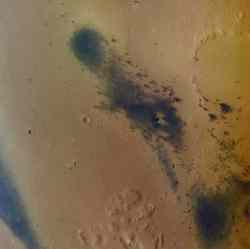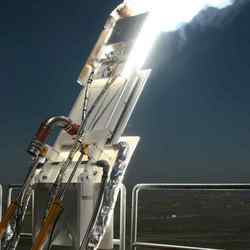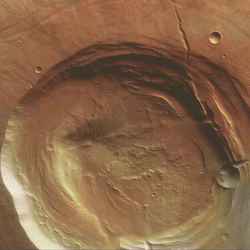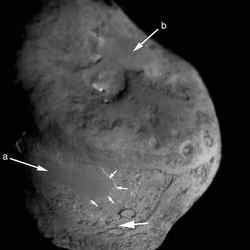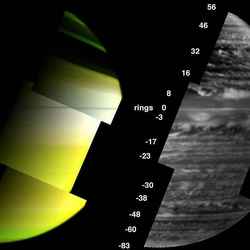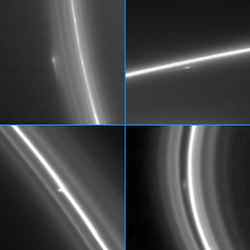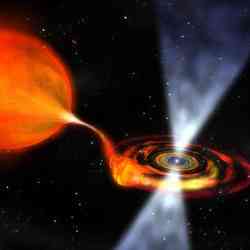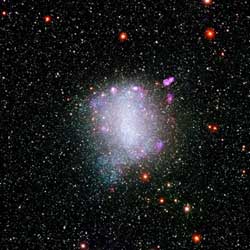
NGC 6822. Image credit: Local Group Galaxies Team/NOAO/AURA/NSF. Click to enlarge.
Monday, September 5 – Tonight the Moon will be an exceptional sighting since it will only appear on the western horizon for a very short time after sunset. If you’re looking for a lunar challenge, then look no further than crater Petavius about one third the distance up from southern cusp. This ancient crater is a wonderland of details when on the terminator. Look for rugged walls interrupted by crater Wrottsley on the northwest corner and the elongated Palitzsch on the southeast. If conditions are stable, power up to look for a massive, multi-peaked central mountain region, along with with a deep scar – Rimae Petavius – cutting diagonally across the waved floor.
With the Moon leaving the scene well before full sky dark, our study for this evening is strictly a telescopic challenge for skilled observers. Set your sites about 2 degrees northeast of easy double 54 Sagittarii, and let’s have a look at NGC 6822.
Often referred to as “Barnard’s Galaxy”, for its discoverer (E.E. Barnard – 1884), this usual customer is actually a member of our local galaxy group. For the 4″ to 6″ telescope, this 1.7 million light year distant object will not be easy, but can be achieved with good conditions. Lower power is essential in even larger scopes, and those into the 12″ to 16″ range will see the NGC 6822 burst into stunning resolution. This author has found that “Barnard’s Galaxy” almost appears like an open cluster overlaid with nebulosity, but the experienced eye will clearly see that the “shine” behind the stars is galactic in nature. It’s a very clumpy and unusual galaxy – one that I think you will very much enjoy. Be sure to look for small, pale blue planetary nebula, NGC 6818 in the same field to the north/northwest. This pair rocks!
Tuesday, September 6 – Today celebrates the founding of the Astronomical and Astrophysical Society of America. Started in 1899, it is now known as the American Astronomical Society.
Tonight’s Moon will be very young. Can you spot its very slender crescent at twilight? You’ll find it less than two degrees away from Jupiter. If you chose to observe it, let’s go further south than last night’s study and have a look at Furnerius. Far more shallow and less impressive than Petavius, Furnerius will fade into obscurity as the days go by. This flooded old crater has no central peak, but it does have a much younger crater that has punched a hole in its lava-filled floor. Look for the long “crack” which extends from Furnerius’ north shore to the crater rim. Perhaps it was caused by the impact? Sharp-eyed observers with good conditions and high power will also spot a multitude of small craters both within and caught along Furnerius’ walls. For binocular viewers, can you spot challenging craters Stevenus to the north and Fraunhofer to the south?
Deep Sky binocular observers – I have not forgotten you. Although I cannot hand you an unusual study such as “Barnard’s Galaxy”, what I can point you toward is an open cluster in Cygnus that will look very similar. Aim your binoculars roughly halfway between Gamma (the central star in the “cross”) and Eta (the next brightest due south). The NGC 6871 is truly remarkable in low power, wide field instruments. You will see around a dozen 7th to 9th magnitude star set in an arc and the area will be surrounded by glow of cluster members beyond your resolution. For those who observe with only your eyes? You’ll see it as a brighter patch against the glow of the Milky Way. It’s a beauty!
Wednesday, September 7 – For our friends in southern Africa, tonight gives you an opportunity to witness an astounding event as the Moon occults brilliant Venus for your location. This is a “don’t miss” opportunity, so please check this IOTA webpages for times and locations. Wishing you the best!
For the rest of us? Don’t hide inside at sunset as the crescent Moon, Jupiter, Venus and Spica will make a wonderful appearance on the western horizon. Look for Venus less than a degree away from the Moon!
While we’re out, let’s have a look at the surface of Selene and head once again toward the confusing southern cusp. Tonight’s challenge will be an usual series of craters known as the Rheita Valley. Look for this unusual feature about one third the distance up from the southern cusp. On the terminator you will spy a collection of three craters which we will study at a later date – from north to south, Metius, Fabricus and Jannsen. From Metius, look northeast for the small crater with the thick walls and small central peak. This is Rheita. Along Rheita’s west wall, look for an unsual marking that appears to be a long runnel cut though the rugged terrain. This 500 kilometer long feature looks as though it might have been the result of a series of impacts that are much older than Rheita itself. You will notice that they appear to lap over one another, ending as they progress through older southern crater Young.
Thursday, September 8 – Today in 1966, a legend was born as the television program, “Star Trek” premiered. Its enduring legend, created by Gene Roddenberry, was instrumental to inspiring several generation’s interest in space, astronomy, and technology. The long running series still airs, along with many movie and series sequels. May it continue to “live long and prosper”.
Still hanging tough on sorting out southern lunar features? Then let’s challenge you a bit further as we head south again tonight in search of Piccolomini. Start by identifying the three-ring circus of Theophilus, Cyrillus and Catherina on the terminator at the western edge of Mare Nectaris. Remember our unofficially named lunar ridge, known as Dorsae Beaumont? Good. Then follow it south across Mare Nectaris and see where it ends in shallow crater Beaumont. Further south you will see the ruined ring of Fracastorius on the mare’s southern edge. Keep moving south, because the next major crater you see will be Piccolomini. This is one outstanding little crater with its very thick walls and brilliant central peak. Congratulations on identifying it!
Now, relax. Tonight the Piscid meteor stream will reach its expected maximum of around 5 meteors per hour. This particular shower favours the southern hemisphere. While this branch of the Piscids is a rather unstudied, unusual and diffuse stream that is active all month, the fairly early set of tonight’s Moon will aid you in keeping an eye out for “shooting stars” emanating in the southeast for the northern hemisphere viewers.
Friday, September 9 – In this day in 1839, John Herschel marks history as he made the very first glass plate photograph – and we’re glad he did! The photo was of the famous 40-foot telescope of John’s father, William Herschel. The scope had not been used in decades and was disassembled shortly after its photograph was taken. Later in 1892, one this same day, Edward Emerson Barnard was busy at Lick Observatory as he discovered Jupiter’s innermost moon – Amalthea.
So are you ready to tour the Southern Highlands again? Then let’s start by relocating full disclosed Theophilus, Cyrillus and Catherina. Head southwest until you spot a very magnificent old crater on the terminator. Congratulations! You’ve just identified Maurolycus. Look for several intruding craters on its northern and southern walls. Now power up! Inside of Maurolycus are several small interior punchmarks, but look closely at its southern and eastern wall. Can you see where the strike that formed Maurolycus has actually partially eclipsed a much older crater? Look at where the three come together, sharing a triple border with crater Barocius to the southeast.
Saturday, September 10 – Today is the birthday of James E. Keeler. Born in 1857, American Keeler was a pioneer in the field of spectroscopy and astrophysics. In 1895, Keeler proved that different areas in Saturn’s rings rotate at different velocities. This clearly showed the Saturn’s rings were not solid, but were instead a collection of smaller particles in independent orbit. Can you spot the “Ring King” in Gemini this morning before dawn?
Tonight for most observers, keep a watch on the waxing Moon as you’ll discover that Antares is less than half a degree away to the south.
And speaking of south, let’s walk the Highlands again! Tonight we are heading due west of Maurolycus for an awesome crater on the terminator – Stofler. Stofler is easy to recognize, because this is one battered crater with some very, very steep walls. Stofler itself is old, and probably would have had a smooth floor had it not been the site of some very nasty impacts. Look at its southeastern wall, where you will see two overlaying craters that are the result of meteoroids slamming into the surface. If that weren’t enough, look further at the southern wall where you will see that four more have punched holes in Stofler’s structure. The west wall is the last remaining untouched bridge, leaving the crater floor below it bathed in shadow from the lunar sunrise.
Sunday, September 11 – Today celebrates the birthday of Sir James Jeans. Born in 1877, English-born Jeans was an astronomical theoretician. During the beginning of the 20th century, Jeans worked out the fundamentals of gravitational collapse process. This is an important contribution to the understanding of the formation of solar systems, stars, and galaxies. With the 2005 success of Deep Impact, let’s turn back the hands of time. Twenty years ago on this date, ICE, the International Cometary Explorer, made history as it flew by Comet Giacobini-Zinner, making it the first mission to reach a comet.
Are you afraid to go south again? Then don’t be. Tonight we’ll be looking at a series of craters that lay along the terminator and border the emerging Mare Nubium. Staring just below the central point, look for a line of descending craters. From north to south, they are Ptlomaeus, Alphonsus, Arzachel, tiny Thebit, Purbach and Walter. Congratulations! You’ve learned more lunar features this week than most folks learn in a year. Be sure to look for Tycho even further south and right on the terminator. Tonight its resemblance to an old analog telephone dial is remarkable. Enjoy it now, because you won’t see it this way tomorrow!
Lunacy has returned. No problem! We’ll just study the Moon until skies turn dark again. Until then? May all your journeys be at light speed… ~Tammy Plotner
